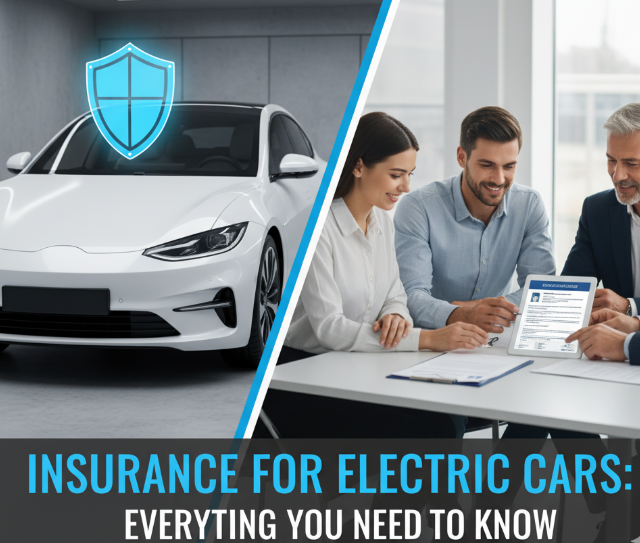Introduction
Electric vehicles (EVs) are no longer the “cars of the future”—they are the cars of today. With more people switching from gasoline-powered cars to EVs, the conversation has expanded beyond range, charging stations, and battery life. One of the most important questions new EV owners face is: how does insurance work for electric cars?
Car insurance has always been a necessity for drivers, but when it comes to EVs, the rules, costs, and coverage options can look a little different. In this guide, we’ll walk through everything you need to know about electric car insurance in 2025—from what makes it different, how much it costs, the best companies offering EV-friendly coverage, to tips for saving money on premiums.
By the end of this article, you’ll have a clear roadmap to make smart insurance decisions for your EV.
Why Insurance for Electric Cars Matters More Than Ever
Unlike gas-powered vehicles, EVs come with unique features—large batteries, advanced technology, and expensive replacement parts. This makes insurance coverage more critical. Here’s why:
- High Repair Costs: EV parts like batteries and sensors can be pricier than regular car components.
- Specialized Mechanics: Not all repair shops are equipped to handle EV technology, which may increase labor costs.
- Battery Protection: Since the battery is the heart of an EV, insurance often needs to cover damage, replacement, and fire risks.
- Government Push for EVs: With tax credits and incentives encouraging EV adoption, more insurers are tailoring policies to suit this market.
Do Electric Cars Cost More to Insure?
This is one of the biggest questions EV buyers ask. The short answer: yes, but not always.
Insurance rates are based on factors like repair costs, safety features, and accident history. EVs tend to be more expensive to repair, but they also come with advanced safety features that may lower risk.
Average Insurance Costs: EV vs. Gas Cars (2025)
| Vehicle Type | Average Annual Premium (2025) | Why the Difference? |
|---|---|---|
| Gasoline Car | $1,600 | Cheaper repairs, more shops available |
| Hybrid Car | $1,750 | More tech, slightly higher parts costs |
| Electric Car (EV) | $2,000 – $2,200 | Expensive batteries, specialized repairs |
👉 Tip: While EV insurance can be higher, incentives like federal tax credits, lower fuel costs, and fewer moving parts often balance out long-term ownership expenses.
What Does Electric Car Insurance Cover?
Most EV insurance policies are similar to regular car insurance but with added attention to EV-specific risks.
Standard Coverage Included in EV Insurance:
- Liability Coverage – Pays if you cause an accident and damage someone else’s car or property.
- Collision Coverage – Covers damage to your EV in a crash, regardless of who’s at fault.
- Comprehensive Coverage – Protects against theft, vandalism, fire, or natural disasters.
- Uninsured/Underinsured Motorist Coverage – Helps if you’re hit by someone without enough insurance.
EV-Specific Coverage Options:
- Battery Coverage – Since batteries can cost $10,000+ to replace, insurers may offer extra protection.
- Charging Equipment Protection – Covers damage to home chargers or public charging incidents.
- Roadside Assistance for EVs – Includes mobile charging or towing to the nearest station.
- Software & Cyber Protection – Covers issues like hacking or software-related failures in smart EVs.
Factors That Affect Electric Car Insurance Rates
Insurance companies consider a mix of vehicle, driver, and location factors when setting rates. With EVs, some unique aspects come into play.
1. Car Model & Value
Luxury EVs like a Tesla Model S or Porsche Taycan cost more to insure than budget-friendly models like a Chevy Bolt or Nissan Leaf.
2. Battery Costs
The battery makes up 30–40% of an EV’s value, and replacement is expensive. Insurers factor this into premiums.
3. Repair Network
If repair shops in your area are limited, labor costs may rise, raising insurance prices.
4. Driver Profile
- Age, gender, driving record, and location still matter.
- Young drivers usually pay the most, whether for EVs or gas cars.
5. Safety Features
EVs come with advanced driver-assist features like automatic braking and lane assistance, which may reduce accident risk (and sometimes lower insurance rates).
Best Insurance Companies for EVs in 2025
Not every insurer offers EV-friendly policies. Some companies are ahead of the curve in providing custom coverage for electric cars.
Top Picks for EV Insurance:
- Progressive
- EV discount programs
- Covers charging equipment
- Snapshot program to reward safe EV driving
- State Farm
- Known for affordable rates on popular EVs
- Bundle options for home EV charger coverage
- GEICO
- Specialized EV insurance add-ons
- Good rates for young drivers with EVs
- Allstate
- Comprehensive roadside EV assistance
- Strong telematics programs to lower premiums
- Tesla Insurance (for Tesla owners only)
- Uses real-time driving data
- Often cheaper than traditional insurers for Tesla drivers
Discounts and Savings on EV Insurance
Just like with traditional cars, there are ways to cut down on premiums.
Common EV Insurance Discounts:
- Multi-Policy Discounts – Bundle home and auto insurance.
- Safe Driver Discounts – Based on telematics or driving history.
- Low-Mileage Discounts – EV owners who drive less pay less.
- EV-Specific Discounts – Some insurers offer unique savings just for owning an EV.
👉 Pro Tip: Ask your insurer if they offer green vehicle discounts—some companies reward drivers for choosing eco-friendly cars.
Tips to Lower Your Electric Car Insurance Premium
- Shop Around – Compare at least 4–5 quotes before choosing.
- Increase Deductibles – A higher deductible lowers monthly costs.
- Install Anti-Theft Devices – Protects expensive EVs from theft.
- Use Telematics – Programs like usage-based insurance can cut costs for safe drivers.
- Take Advantage of Bundling – Combine EV insurance with homeowners or renters insurance.
- Leverage Government Incentives – Some states give tax breaks or rebates that indirectly reduce insurance costs.
EV Insurance by Popular Model (2025 Estimates)
| EV Model | Average Annual Insurance Cost | Notes |
|---|---|---|
| Tesla Model 3 | $1,950 | Affordable compared to other Teslas |
| Tesla Model Y | $2,200 | High repair costs, but good safety rating |
| Ford Mustang Mach-E | $1,850 | Lower than Tesla, wider repair access |
| Nissan Leaf | $1,600 | Budget-friendly EV, cheaper premiums |
| Rivian R1T | $2,300 | Newer brand, fewer repair shops |
| Chevy Bolt EUV | $1,700 | Affordable option, moderate repair costs |
Common Myths About EV Insurance
- “EVs Are Always Way More Expensive to Insure.”
- Not true. Some budget EVs have insurance rates close to gas cars.
- “EV Insurance Doesn’t Cover Batteries.”
- Many policies specifically include battery protection.
- “Tesla Insurance Is Always Cheapest.”
- Tesla insurance is great for Tesla owners, but sometimes GEICO or State Farm may offer better deals.
- “Only Luxury EVs Need Special Coverage.”
- All EVs, even budget models, benefit from coverage for chargers, batteries, and roadside assistance.

The Future of EV Insurance
As EVs continue to grow in popularity, insurance is expected to become cheaper and more flexible. Trends to watch in 2025 and beyond:
- Pay-Per-Mile Insurance: Perfect for EV owners who drive less.
- Real-Time Driving Data: More insurers may follow Tesla’s model of adjusting premiums based on driving habits.
- Cybersecurity Protection: EVs run on software, and future policies will cover hacking risks.
- Battery Leasing Programs: Insurance may adapt to cover leased batteries differently than owned ones.
Key Takeaways
- Electric car insurance is slightly more expensive than gas cars, but long-term EV ownership savings make up for it.
- Coverage usually includes battery protection, charging equipment, and EV-specific roadside assistance.
- Top insurers like Progressive, State Farm, GEICO, Allstate, and Tesla offer strong EV insurance options.
- You can save money through discounts, bundling, telematics programs, and safe driving.
- The insurance industry is adapting quickly, and by 2030, EV insurance rates are expected to match or even fall below gas car insurance.
Conclusion
Owning an electric car is exciting—you save on gas, reduce emissions, and drive cutting-edge technology. But just like with any car, the right insurance is what protects your investment and keeps you financially safe.
While EV insurance may currently cost a bit more than traditional car coverage, smart shopping, discounts, and EV-specific policies can bring premiums down. As more insurers compete in the EV space, expect better rates, more tailored coverage, and innovative options in the years ahead.
If you’re thinking about buying an EV—or you already own one—take the time to compare insurers, ask about EV discounts, and make sure your battery and charging equipment are fully protected. That way, you’ll not only enjoy the ride but also have peace of mind every mile of the journey.

Leave a Reply